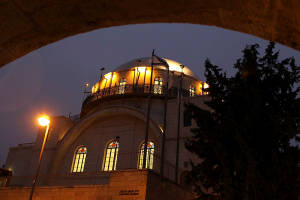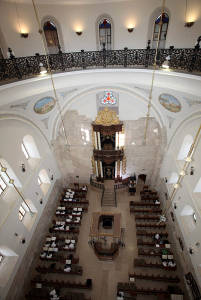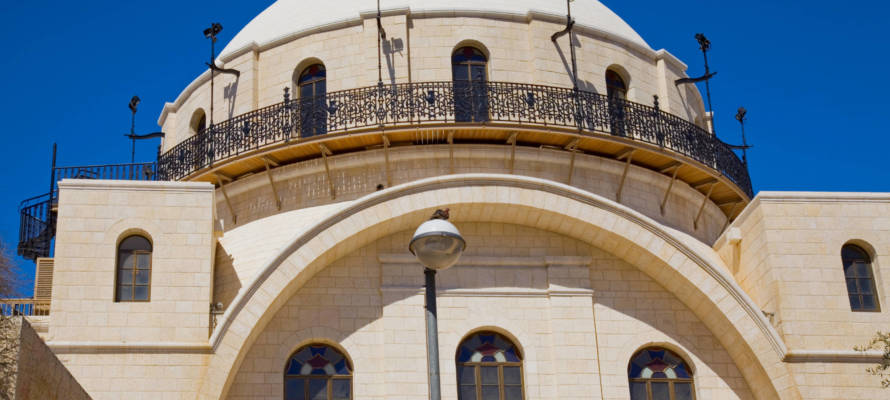The Ruins Synagogue in Jerusalem’s Old City represents the tenacity of the Jewish people to forge ahead even when seemingly destroyed. Indeed, on Jerusalem Day – Yom Yerushalayim – Israelis celebrate the liberation of the Holy City in 1967.
By Moshe Rothchild
When roaming around the Jewish Quarter of the Old City of Jerusalem, it is impossible to miss the large, white-domed synagogue. This building is the Hurva Synagogue, which means the Ruins Synagogue—a very strange name indeed. Of course, there is a story behind the name, and here it is:
In the year 1700, Rabbi Yehuda Hachasid was intent on emigrating from Europe with his followers to Jerusalem in order to hasten the arrival of the Messiah. By building a community of people who were ready to rebuild the Temple and create the facts on the ground, how could God deny them? Unfortunately, just a few days after he arrived with 500 followers, he passed away, and without a leader, the community began to dissipate.
Those who remained built about 40 homes and a small synagogue. Eventually, they were interested in building a much larger and more attractive synagogue, but this proved well beyond the means of this small community. To make it happen, they borrowed money from the local Arab population. The synagogue was built, but the debt to the Arabs was never paid. Finally, in 1720, the Arabs lost patience waiting for the loan to be repaid and simply destroyed the synagogue. The synagogue was left in ruins, and it became known as the Hurva shel Rabbi Yehuda HaChasid (The Ruins of Rabbi Judah the Pious).
It remained as such for about 100 years when finally, in 1819, the Jewish community of Jerusalem received a firman (royal decree) from the ruling Ottoman Empire cancelling the debt. It was not until the 1850s that reconstruction began. The Baron Alphonse de Rothschild laid the cornerstone, and finally, in 1864, the building was complete and dedicated. The synagogue was named Beit Yaacov (House of Jacob) in memory of Jacob Meyer Rothschild, whose son Edmond was critical in the development of so many new settlements in what was then Palestine.

(Nati Shohat/Flash90)
The synagogue was designed by Assad Effendi, who was the architect to the Sultan of the Ottoman Empire. The structure was enormous and contained a beautiful dome with 12 windows around the base. This landmark building could be seen for miles. From 1864 until 1948 it was considered the most beautiful and important synagogue in the Land of Israel. It was the site where the Chief Rabbis of both Palestine and Jerusalem were installed. Rabbi Abraham Isaac Kook, the first chief rabbi of Palestine, was appointed in the synagogue in 1921.
Despite its official name being the Beit Yaacov synagogue, it was referred to by all as The Hurva (the ruins). In 1948, during the War of Independence, the Jewish Quarter of Jerusalem fell to the Jordanians. The Hurva Synagogue, along with 57 others, were systematically destroyed by the Jordanians. Jerusalem would remain a divided city for 19 years.
In 1967, during the Six Day War, Jerusalem was once again reunited as the eternal capital of the Jewish people and the State of Israel. There was much debate about what to do with the destroyed synagogue and finally, in 1977, a memorial arch to the grand building that once stood there was erected.

Interior of the synagogue. (Yossi Zamir/Flash 90)
In the year 2000, the government of Israel approved of a plan to rebuild the Hurva Synagogue. It took 10 years to solve all the issues involved in reconstruction, but on March 15, 2010, the synagogue was completed and dedicated.
The story of the Hurva is, in many ways, a microcosm of the story of the Jewish people. It is about a longing to return to the land, it is about Messianic hopes, and it is also about those hopes being dashed. It also represents the tenacity of the Jewish people to move forward when destruction occurs. Throughout the centuries, the Jewish people held on to the hope that there will once again be an opportunity to rebuild our ancient homeland. The Hurva was destroyed twice and rebuilt twice; the Jewish people were exiled from the Land of Israel twice and we have returned twice. We are a people of great hope, and we have learned that it is forbidden to ever give up. Hope is the fuel that drives the engine of Jewish history.










